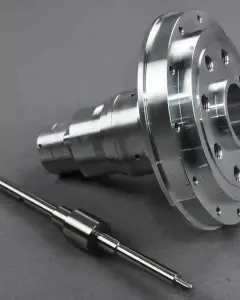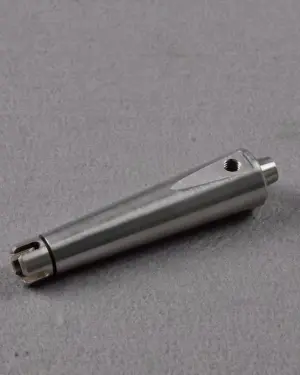Introduction to Tapered Shafts
In the world of machinery and engineering, tapered shafts play a crucial role as key components in power transmission systems. These shafts are designed with a gradual reduction in diameter, providing enhanced stability and alignment compared to their straight counterparts. Whether in automotive engines, industrial machinery, or precision equipment, tapered shafts ensure efficient energy transfer and reliable operation.
Types and Varieties of Tapered Shafts
Tapered shafts come in various designs tailored to specific applications and operational requirements. Straight Tapered Shafts maintain a consistent taper along their length, offering simplicity and reliability in power transmission. Stepped Tapered Shafts, on the other hand, feature multiple diameters in their taper, allowing for versatile coupling options and precise torque transmission.
Components of Tapered Shafts
Understanding the anatomy of a tapered shaft involves recognizing its essential components. A Taper Lock Bush secures the shaft to the mating component, such as a pulley or gear, ensuring a robust and backlash-free connection. Couplings facilitate alignment and torque transmission between shafts, crucial for maintaining operational efficiency and minimizing vibration.
Materials Used in Tapered Shafts
Manufacturers select materials based on specific operational requirements and environmental conditions. Steel remains a preferred choice for its strength and durability, ideal for heavy-duty applications where reliability is paramount. Stainless Steel offers corrosion resistance, making it suitable for applications exposed to moisture and harsh environments.
Manufacturing Processes for Tapered Shafts
The production of tapered shafts involves precise manufacturing processes to meet stringent quality standards.
Precision Machining techniques such as turning, milling, and
grinding ensure dimensional accuracy and surface finish. Advanced CAD/CAM technologies enable complex geometries and customizations, catering to diverse industry needs.
Applications and Industries Using Tapered Shafts
Tapered shafts find extensive use across various industries, including automotive, aerospace, and manufacturing. In Automotive Engineering, they are integral to transmission systems, ensuring smooth power delivery from engines to wheels. In Aerospace Applications, tapered shafts support critical systems where lightweight and reliability are paramount.
Advantages of Tapered Shafts
Compared to straight shafts, tapered shafts offer several advantages. Their tapered design enhances Mechanical Stability and reduces stress concentrations, resulting in improved fatigue resistance and longer service life. Ease of Installation with taper lock mechanisms simplifies assembly and maintenance procedures, contributing to overall operational efficiency.
Tapered Shaft vs. Straight Shaft
When comparing tapered shafts to straight shafts, it’s essential to understand their distinct characteristics and applications.
Design and Structure
Tapered Shafts:Tapered shafts feature a gradual reduction in diameter along their length, enhancing mechanical stability and reducing stress concentrations. This design minimizes shaft deflection and improves fatigue resistance, making them ideal for applications requiring precision and reliability.
Straight Shafts: In contrast, straight shafts maintain a consistent diameter from end to end. While simpler in design, straight shafts may experience higher stress concentrations at connection points, potentially leading to premature wear and reduced lifespan in demanding operational environments.
Performance and Efficiency
Tapered Shafts: The tapered design of these shafts allows for efficient torque transmission and reduced vibration, contributing to smoother operation and enhanced system reliability. Tapered shafts are particularly advantageous in applications where space constraints or weight considerations are critical factors.
Straight Shafts: Straight shafts are straightforward in their operation and installation, often used in less demanding applications where precise alignment and vibration reduction are not primary concerns. They remain suitable for tasks where cost-effectiveness and simplicity are prioritized over specialized performance characteristics.
Application Specificity
Tapered Shafts: Due to their superior mechanical properties and design versatility, tapered shafts are preferred in industries such as automotive engineering, aerospace, and heavy machinery. They excel in environments requiring high precision, minimal vibration, and optimal energy transfer efficiency.
Straight Shafts: Straight shafts find application in a wide range of industries, including basic machinery, pumps, and electric motors. Their straightforward design and ease of maintenance make them suitable for tasks where standardization and interchangeability are advantageous.
Considerations When Choosing Tapered Shafts
Selecting the right tapered shaft involves evaluating specific operational factors and performance criteria. Considerations such as Torque Requirements, Environmental Conditions, and Load Capacities influence material selection and shaft design, ensuring optimal performance under varying operating conditions.
Maintenance and Care Tips for Tapered Shafts
To maximize the lifespan of tapered shafts, regular maintenance practices are essential. Conduct Periodic Inspections for signs of wear, misalignment, or corrosion. Ensure proper Lubrication of bearings and couplings to reduce friction and prevent premature failure, enhancing overall system reliability and longevity.
Future Trends in Tapered Shaft Technology
As industries continue to advance in automation and precision engineering, tapered shaft technology evolves alongside. Innovations in Composite Materials promise lighter yet durable shafts, contributing to energy efficiency and reduced environmental impact. Digital Monitoring Systems enable real-time performance analysis, optimizing maintenance schedules and minimizing downtime.
Conclusion
In conclusion, tapered shafts represent a cornerstone in modern mechanical engineering, offering superior performance and reliability across diverse applications. As technology continues to innovate, the future of tapered shafts holds promising advancements in materials, manufacturing techniques, and application versatility.
FAQs
What is a taper lock bush, and how does it work?
A taper lock bush secures tapered shafts to mating components like pulleys or gears, utilizing a tapered design to create a tight, frictional fit.
What are the benefits of using tapered shafts over straight shafts?
Tapered shafts provide better mechanical stability, reduced stress concentrations, and easier installation with taper lock mechanisms.
How are tapered shafts manufactured?
Tapered shafts undergo precision machining processes such as turning, milling, and grinding to achieve precise dimensions and surface finishes.
What industries use tapered shafts?
Tapered shafts find applications in automotive, aerospace, manufacturing, and various industrial sectors requiring reliable power transmission.
How do you maintain tapered shafts for optimal performance?
Regular inspections, proper lubrication, and adherence to maintenance schedules are crucial for extending tapered shaft lifespan and ensuring operational efficiency.


